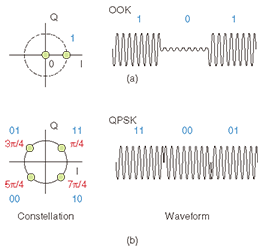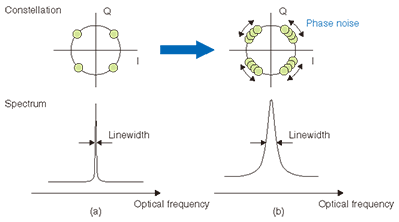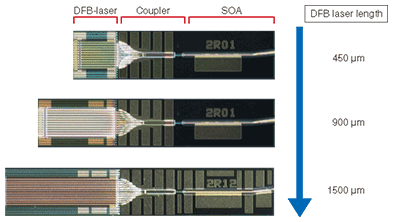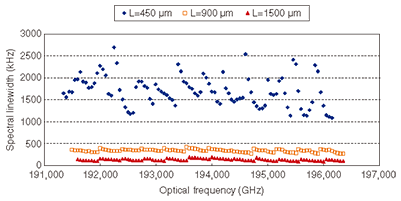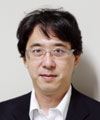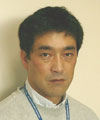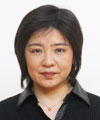 |
|||||||||||||||||||||||||||||
|
|
|||||||||||||||||||||||||||||
|
Feature Articles: R&D of Optical Component Technologies for 100-Gbit/s Digital Coherent Communications Vol. 9, No. 3, pp. 42–47, Mar. 2011. https://doi.org/10.53829/ntr201103fa7 Wavelength-tunable Lasers for Next-generation Optical NetworksAbstractWavelength-tunable lasers are key components as light sources in large-capacity optical core networks that use dense wavelength-division-multiplexing techniques. In next-generation optical networks, an advanced modulation/detection technique will be used, and low phase-noise characteristics will be essential for tunable laser sources. This article reviews techniques for reducing the phase noise of tunable lasers and describes a narrow-linewidth tunable distributed feedback laser array that we have developed.
1. IntroductionThe rapid increase in Internet traffic has accelerated the growing demand for greater traffic capacity in recent years. Dense wavelength-division-multiplexing (DWDM) techniques have been developed to increase the transmission capacity by increasing the number of wavelength channels. In commercial photonic network systems, 80–100 wavelength channels are multiplexed on one optical fiber. Early DWDM systems used fixed-wavelength lasers as light sources, which meant that many kinds of optical transceivers were needed for the wavelength channels. The use of tunable lasers, which can operate at any channel wavelength, means that only one kind of transceiver is needed, so the inventory cost can be reduced. Various kinds of tunable laser have already been developed for this purpose [1]. Tunable lasers are now widely used as light sources in DWDM systems. However, it is difficult to increase the number of wavelength channels and thus further expand the transmission capacity owing to the wavelength range limitation of the optical fiber amplifier. Therefore, a lot of research has concentrated on increasing the signal data rate per wavelength channel. In commercial systems, the fastest data rate per channel is 40 Gbit/s. In next-generation systems, it will be 100 Gbit/s, and an advanced modulation/detection technique, namely a digital coherent system, is expected to be used. In such systems, the tunable lasers are used both as a light source in the transmitter and as a local oscillator in the receiver. In digital coherent systems, the light sources must have low phase-noise characteristics because the phase of the lightwave is used as information. This article reviews techniques for reducing the phase noise of tunable lasers. The required performance of the light source in digital coherent systems is described, and the development status of an applicable tunable laser is reported. Moreover, narrow-linewidth operation is demonstrated in a widely tunable laser array with stable lasing characteristics. 2. Light sources in digital coherent systemsAn intensity modulation/direct detection (IM/DD) technique called on-off keying (OOK) is used in optical networks with a data rate of 10 Gbit/s or less. As shown in Fig. 1(a), in OOK a data bit [1, 0] is allocated to the intensity of the light. The IM/DD method is widely used because it has the simplest optical component configuration and the most cost-effective method. However, it is difficult to use IM/DD for long-haul transmission with a data rate over 10 Gbit/s because of various limitations such as fiber dispersion, limited wavelength channel spacing, and the speed limitations of electrical circuits. To avoid these limitations, a phase-shift-keying/differential detection method is used in 40 Gbit/s systems, and a phase-shift-keying/digital coherent detection method will be used in next-generation 100-Gbit/s systems. To make best use of the limited wavelength resource, a multilevel modulation format is used in 100-Gbit/s systems. Quadrature phase shift keying (QPSK) is a four-level modulation format. As shown in Fig. 1(b), four phase states [π/4, 3π/4, 5π/4, 7π/4] of the lightwave are allocated to two data bits [11, 01, 00, 10]. As a result, the data rate is twice that of a binary modulation signal for the same baud rate. Polarization multiplexing is also used, so the data rate is doubled. Thus, the four-level modulation format and polarization multiplexing enable four 25-Gbaud signals to generate a 100-Gbit/s data signal. Since the baud rate is suppressed to only 25 Gbaud, the modulation spectrum bandwidth is also suppressed to less than 50 GHz. Therefore, this method can be introduced into a DWDM system with a 50-GHz grid spacing. On the receiver side, the phase state of the signal is detected with a coherent detection scheme, where the relative phase of the signal is compared with the phase of a local light source. And a polarization diversity technique is used for the signal polarization state. In digital coherent systems, a tunable laser is also used on the receiver side.
In IM/DD systems, the phase noise of the laser is not an issue because the phase is not used as information. On the other hand, it is a critical issue in digital coherent systems, as described below. In a digital coherent receiver, the frequencies of the local and signal lights should not be exactly the same. The frequency offset is compensated for in a digital signal processor. Although this can compensate for low-speed variations in the phase or frequency, it cannot compensate for high-speed variations due to the intrinsic phase noise of the light sources. Therefore, the phase noise characteristics of the light sources have a great influence on system performance. The spectral linewidth is often used as an index of the amount of phase noise. As shown in Fig. 2, when the linewidth is sufficiently narrow, the phase state can be clearly detected in the constellation map. As the linewidth increases, the phase angle variation increases and the phase state can no longer be identified. In a 100-Gbit/s system, a linewidth of 1 MHz or less is required for both the transmitter light source and the local light source [2].
3. Widely wavelength tunable lasersIn the last ten years, various kinds of tunable lasers have been developed, and their performance has been greatly improved. A tunable laser consists of a semiconductor gain region and a wavelength-tunable optical filter. The wavelength is tuned by changing the filter wavelength. Tunable lasers are classified into three structural types: an external cavity laser [3], a distributed feedback (DFB) laser array [4], and a distributed Bragg reflector (DBR) laser [5]–[7]. All of these laser structures provide a tuning range of more than 35 nm, which is required for DWDM systems. The features of the three lasers are summarized in Table 1.
The external cavity laser consists of a gain chip and spatially separated external optical filters, which are packaged into a compact optical module by using a hybrid integration technique. This type can easily provide a wide tuning range because optimum optical filters can be selected. For example, external cavity lasers with thermally tunable silicon etalon filters have been commercialized for use in tunable transceivers [8]. Generally, the cavity length is long, and a narrow linewidth of less than 100 kHz can be easily achieved. This laser is a strong candidate for a light source for digital coherent systems. Its drawbacks are that complex tuning control is needed to suppress mode hopping and that it has many optical parts. The DFB laser array is based on the DFB laser, which has been widely used in commercial optical networks for a long time. The tuning range is expanded by integrating DFB lasers of different wavelengths. An excellent feature of this laser is its mode stability and reliability owing to its mode-hop-free tuning characteristics. Moreover, it is suited to mass production because it is a monolithic chip. Its drawback is its slow wavelength tuning, which is achieved through temperature control. DFB array lasers are widely used in current 10-Gbit/s systems. The linewidth of the conventional DFB laser is several megahertz. However, a narrower linewidth can be obtained by optimizing the cavity structure. Linewidth reduction of a DFB laser array is described in detail in the next section. A DBR laser is also a monolithic chip. The wavelength can be tuned by controlling the refractive index of the semiconductor-based DBR. Generally, the refractive index is changed by a carrier plasma effect induced by current injection. Therefore, the tuning time is a short as a few nanoseconds. Its drawback is that the linewidth is increased when the tuning current is injected. However, it has been reported that a DBR-type laser with heaters for temperature-based wavelength tuning has a narrow linewidth even during wavelength tuning [9]. As described above, all three laser types have both advantages and disadvantages, and they will be used according to the required application. 4. Narrow-linewidth tunable DFB laser arrayWe have developed a tunable DFB laser array (TLA) [10], [11] because stable mode characteristics are a great advantage in photonic networks. We have reduced its spectral linewidth, as described below, to make it applicable to 100-Gbit/s systems. The linewidth in semiconductor lasers is proportional to the ratio of the spontaneous emission noise to the total photon number in the laser cavity [12]. In general, the linewidth can be reduced because the total photon number increases if the laser cavity is lengthened. We fabricated TLAs having longer-cavity DFB lasers and confirmed the linewidth characteristics. Photographs of the TLA chips are shown in Fig. 3. The TLA consists of an array of 12 DFB lasers, a 12 × 1 multimode interference (MMI) optical coupler, and a semiconductor optical amplifier (SOA). The output light from each DFB laser is introduced into the MMI coupler through an S-bend waveguide, and the light from the MMI coupler is amplified by the SOA. The length of the SOA region is 1200 ¦Ìm. We fabricated three types of TLA with DFB laser lengths of 450, 900, and 1500 μm. The three types have the same structure except for the DFB laser length. The DFB lasers and SOA have an active layer composed of compressively strained multiple quantum wells, which is designed to achieve low threshold operation over a wide DFB laser temperature range. The passive waveguide regions consist of an InGaAsP bulk layer with a bandgap wavelength of 1.3 μm. The waveguide was formed with a buried heterostructure of p-n current blocking layers. A l/4-shifted grating was formed on the DFB laser region by electron beam lithography and wet etching to determine the lasing wavelength precisely. The wavelengths of the lasers were initially set to roughly those specified in the ITU-T grid [13] with a spacing of 400 GHz by designing the grating pitch, which corresponds to wavelength tuning with a temperature change of 35ºC (ITU-T: International Telecommunication Union, Telecommunication Standardization Sector). Therefore, the TLA can be operated at an arbitrary optical frequency within a range of 4.8 THz (= 12 × 400 GHz).
The TLA chip was packaged in a butterfly-type pigtail module together with a wavelength locker. The chip contained two thermoelectric coolers: one for the laser and the other for the wavelength locker. It also had two lenses for optical coupling and an optical isolator. The optical coupling efficiency from the chip output to the fiber was about -2 dB. The spectral linewidth on the 97 frequency grids with a 50-GHz spacing is shown in Fig. 4. To adjust the frequency on the ITU-T grid, we controlled the laser temperature in the 15–50°C range. The current to the SOA was controlled to maintain fiber output power of 20 mW (13 dBm). The three TLAs covered a frequency range of 4.8 THz. A side-mode suppression ratio of more than 45 dB was obtained for all the frequency grids. We measured the spectral linewidth with a delayed self-heterodyne method using a 5-km single-mode fiber and a 150-MHz acoustic-optic modulator. The linewidths of the TLAs with DFB laser lengths of 450, 900, and 1500 μm were 1–3 MHz, 300–600 kHz, and 90–160 kHz, respectively. Thus, the linewidths improved with increasing cavity length. The linewidth of a TLA with a DFB laser length of 900 or 1500 μm is less than 1 MHz, which meets the requirement for a 100-Gbit/s system.
5. ConclusionsFor the 100-Gbit/s system now being developed as a next-generation optical communication system, we have developed a high-performance tunable laser array with low phase-noise characteristics. Narrow linewidth operation of 90–160 kHz was demonstrated using a TLA with 1500-μm-long DFB lasers. In addition to the linewidth characteristics described here, the tunable laser requires higher power, a wider tuning range, and lower power consumption. Research and development will continue with the aim of obtaining tunable lasers with even better performance. References
|
|||||||||||||||||||||||||||||








